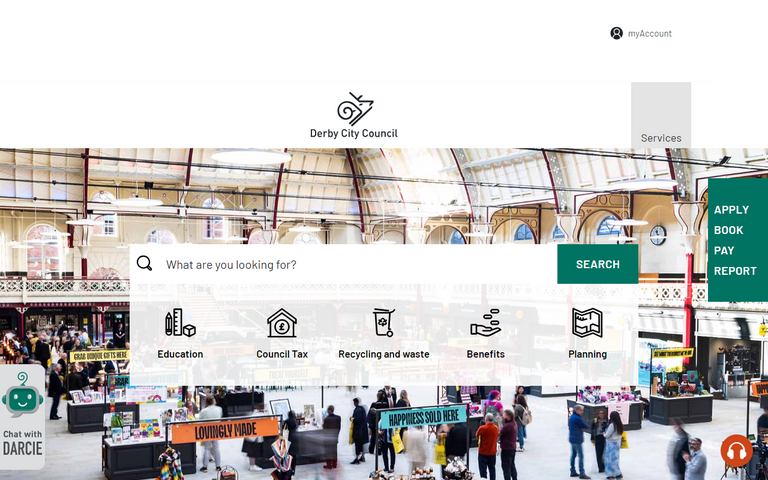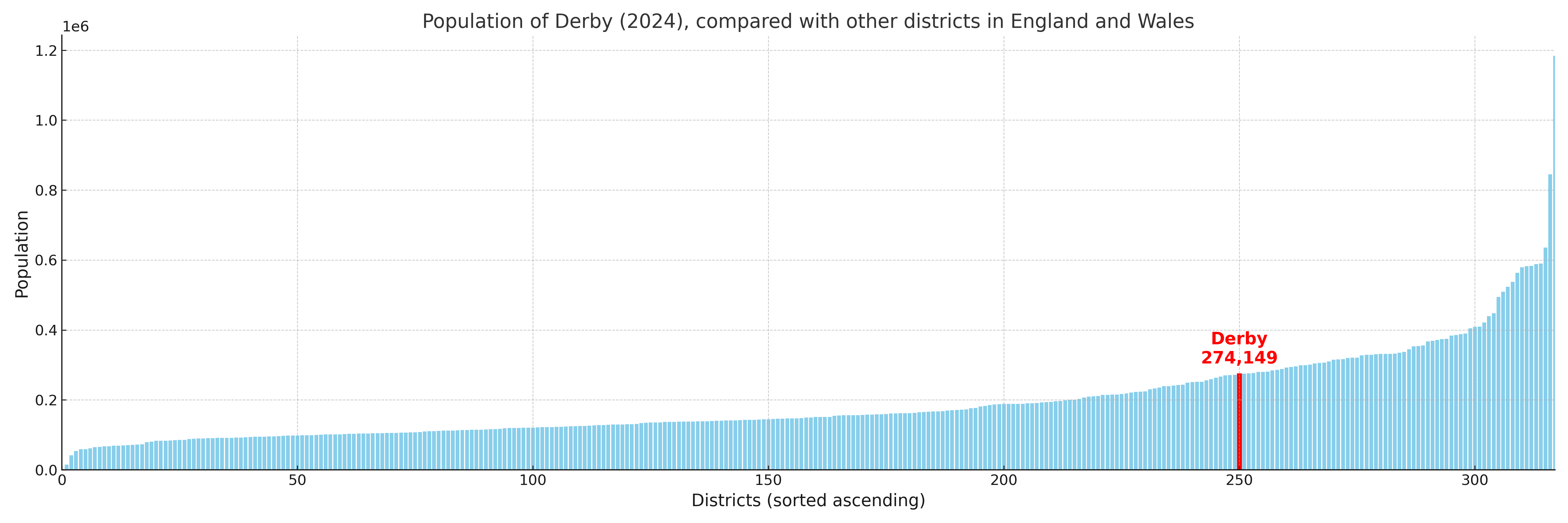Derby
§ This page gives an overview of the Derby local authority district, bringing together key facts, maps, and data to help you quickly understand the area. One of 361 district profiles on Baseview.
Overview ⁞ Derby is a historic city on the River Derwent, known as one of the birthplaces of the Industrial Revolution. Landmarks include Derby Cathedral with its tall tower, the Museum of Making at Derby Silk Mill, and the Arboretum, England’s first public park. The city combines historic streets, Victorian architecture, and modern shopping areas with green spaces along the river. Its location on the edge of the Peak District makes it a cultural hub with easy access to scenic countryside.
Derby Boundary Map
This map shows the official boundary of the Derby local authority district, based on the latest geographic data published by the Office for National Statistics (ONS). It provides a clear view of the district’s extent and helps you understand how the area fits within the wider regional and national landscape.
Contains OS data © Crown copyright and database right 2025. Source: Office for National Statistics licensed under the Open Government Licence v3.0.
The administrative boundary of Derby can also be viewed on OpenStreetMap: District Boundary of Derby.
Key Facts about Derby
What region is Derby in? Derby is in the East Midlands of England, a region within the UK.
What county is Derby in? Derby is in the county of Derbyshire.
Is Derby a city? Yes, Derby is a city. Derby holds official city status as one of the 76 designated cities in the UK.
Who governs Derby? The local government for this district is: Derby City Council (Unitary Authority).
▶ Official website of Derby City Council 🔗 derby.gov.uk

Which police force covers Derby? Policing in Derby is provided by Derbyshire Constabulary 🔗 derbyshire.police.uk, which serves 9 local authority districts: Amber Valley ⁞ Bolsover ⁞ Chesterfield ⁞ Derby ⁞ Derbyshire Dales ⁞ Erewash ⁞ High Peak ⁞ North East Derbyshire ⁞ South Derbyshire.
Derby in International Geographies
In the International Territorial Levels (ITLs) hierarchy, Derby is within one of ITLs Level 2 area, Derbyshire and Nottinghamshire, that contains the following 6 ITLs Level 3 areas:
(ITL 1) East Midlands
(ITL 2) ⇒ Derbyshire and Nottinghamshire
(ITL 3) ⇒⇒ Derby ⁞ East Derbyshire ⁞ South and West Derbyshire ⁞ Nottingham ⁞ North Nottinghamshire ⁞ South Nottinghamshire
The International Territorial Levels are used by OECD member countries for statistical purposes to classify administrative areas. We have this listable page for easy browsing of ITL names and codes: International Territorial Levels.
Constituencies in Derby
Derby is divided into 3 parliamentary constituencies, listed below in alphabetical order.
A constituency is a specific geographical area that elects one Member of Parliament (MP) to represent them in the House of Commons. The United Kingdom is divided into 650 parliamentary constituencies. We have this list page for easy browsing of all UK parliamentary constituencies: List of Constituencies.
Wards in Derby
Derby is divided into 18 wards, listed below in alphabetical order.
- Abbey
- Allestree
- Alvaston North
- Alvaston South
- Arboretum
- Blagreaves
- Chaddesden East
- Chaddesden North
- Chaddesden West
- Chellaston & Shelton Lock
- Darley
- Littleover
- Mackworth & New Zealand
- Mickleover
- Normanton
- Oakwood
- Sinfin & Osmaston
- Spondon
In the UK, a ward is a subdivision of a local authority area, used mainly for electoral and statistical purposes. Defined by the ONS, wards represent the primary unit for local elections, each returning one or more councillors to the local council. Wards are also used as a key geography for presenting population and census data.
Parishes in Derby
Derby is entirely unparished—there are no civil parishes in this local authority district.
Parishes are the lowest tier of local government; where they don’t exist, those very local services and representation sit directly with the principal council.
Built-up Areas in Derby
Derby covers 4 built-up areas, listed below in alphabetical order.
- Borrowash *
- Derby *
- Little Eaton *
- Quarndon *
In the UK, a Built-up Area (BUA) is a continuous urban area of at least 20 hectares (0.2 km²), defined by the ONS as land where buildings are generally no more than 200 metres apart, such as towns, cities, or large villages. (Note: A BUA name marked with an asterisk (*) indicates that the area is situated partly in the district of Derby.)
Derby compared with other districts in the UK
This section shows how Derby compares with other local authority districts in the UK, using a variety of measures and rankings.
Derby has 18 electoral wards.

Derby has a population of 274,149 (2024 mid-year estimate by ONS)

More local statistics and data for Derby can be found on the ONS statistics for Derby.